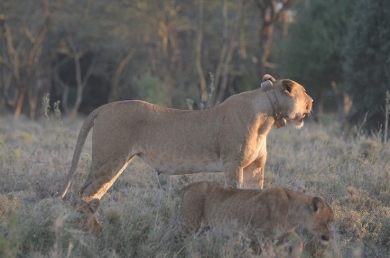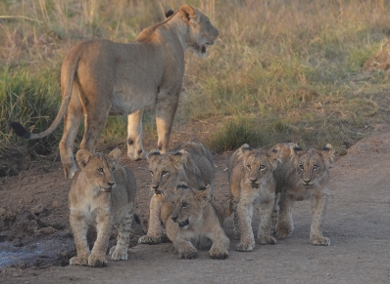Onderzoeksproject
Human-lion conflict around Nairobi National Park: Lion Population Structure, Diet, and Movement in a Semi-Fenced Park.
What is the population size and social structure in time and space? What is the lion diet and food preference in time and space? What is the home range (MCP and Kernel) and movement in time and space? What are human – lion conflict and responses of lions to traditional herding in time and space? What is the mitigation on human – lion conflict?
- Looptijd
- 2014 - 2018
- Financiering
-
 Kenya Wildlife Service
Kenya Wildlife Service
-
 Leo Foundation
Leo Foundation
-
 WWF-INNO
WWF-INNO
-
 Safaricom-Kenya
Safaricom-Kenya
-
 Louwes Fellowship Program
Louwes Fellowship Program
- Partners
Partners
- Kenya Wildlife Service
- Dr. C. (Charles) Musyoki
- Amboseli Lion project
- Leo Foundation
- Kenya Wildlife Service

Short abstract
Human-lion conflict has been an increasing problem in Kenya, especially around Nairobi National Park. In recent years Nairobi National Park lions have experienced a serious threats due to retaliatory killing by local com
munities outside the park. The main aim of my PhD research is to analyze factors contributing to lion-livestock conflicts around Nairobi National Park (NNP). For the conservation of the lions, especially a better understanding of the factors influencing human-lion conflicts will help to develop science based solutions to resolve human – lion conflict.
Project description
The population of lions has declined in Kenya from 2,700 in 2000 and 2,200 in 2009, especially in pastoral community areas, which have been a stronghold for lions. Such a stronghold is represented by Nairobi National Park and its adjacent livestock areas. This park is located in the outskirts of the Nairobi urban conglomerate The southern part of Nairobi National Park is not fenced and being the migratory corridor of wildlife, the lions have been exiting the park and causing increasing conflicts during the past years. The increasing trend of lions raiding livestock behavior in the southern buffer zones of Nairobi National Park has resulted in increased livestock predation and the retaliatory killing of 6 lions 2012.

Globally, conservation biologists generally encourage human-wildlife co-existence through conflict-mitigation programs, compensation schemes or payments for tolerance. However, despite coexisting for millennia, recent human activities have caused declines in carnivore populations and contraction of their geographic ranges. Especially large and dangerous carnivores, such as the lion, present a challenge in conservation science because of their large ranges, low densities and high propensity to livestock conflicts. Subsequent to recent retaliatory lion killings after livestock depredations, there is now an acute need for successful conflict mitigation to ensure the future existence of lions in Nairobi National Park.
My PhD research will focus on the conservation of lions inside Nairobi National Park and in the surrounding areas in relation to human – lion conflict around the park. I will look into factors influencing human-lion conflict, the lion’s prey choice and diet and home ranges and movements in a semi-fenced park. I will also cover with my research socio- economic aspects such as herding practices and traditional mitigation measures in contrast to modern measures (flash lights) and I will analyze their effectiveness against lion attacks.
 The Nairobi National Park (NNP) Lion Project is a collaboration between the Institute of Environmental Sciences (CML) Leiden University in the Netherlands, Kenya Wildlife Service (KWS) and the Leo Foundation in the Netherlands. The lion collaring program is funded by the Safaricom Foundation – Kenya and WWF-INNO. The Nairobi lion collaring was done on 25 -26
th January, 2014 and during 31 January until 5 February 2015
The Nairobi National Park (NNP) Lion Project is a collaboration between the Institute of Environmental Sciences (CML) Leiden University in the Netherlands, Kenya Wildlife Service (KWS) and the Leo Foundation in the Netherlands. The lion collaring program is funded by the Safaricom Foundation – Kenya and WWF-INNO. The Nairobi lion collaring was done on 25 -26
th January, 2014 and during 31 January until 5 February 2015
In this research we are looking for conflict mitigative measures in five research topics:
- Lion population size, structure and dynamics in Nairobi National Park
- Nairobi National Park Lions diet and food preference
- Nairobi National Park Lions home range and movement
- Causes of lion - human conflict and responses of lions to traditional herding
- Effectiveness of mechanisms of conflict prevention and mitigation in Nairobi National Park
In this project all the five research topics will cover causal factors related to livestock raiding behaviour of lions and the effectiveness of mitigative measures in NNP.
- Beveridge N.G.P., Francis Lesilau and Hans. de Iongh (2014) Human-Lion conflicts around Nairobi National Park, Kenya: Analyzing factors contributing to lion-livestock conflicts: prey/biomass availability, lion diet and prey preference, and lion population size and livestock losses. (Msc thesis not published)
- Matteo Lattuada, Hans de Iongh, Charles Musyoki, and Francis Lesilau (2014) Lion-human conflict around Nairobi National Park: Analysis of the lion population and the interaction with the community surrounding Nairobi National Park (Msc thesis not published).
- Myrthe Fonck, Hans de Iongh, Gerard J. J. Driessen and Francis Lesilau (2014) Human-lion conflicts in the Nairobi National Park:
Lion diet and factors influencing lion prey choice (Msc thesis not published)
- Michelle Joanne Christine Kral, Hans de Iongh, Charles Musyoki and Francis Lesilau Human-Lion conflicts around Nairobi National Park, Kenya(2014)Lion (
Panthera leo leo) demography and home ranges relating to local husbandry and attacks on local livestock (Bsc. thesis not published)
- M. J. C. Kral, Hans H. de Iongh , Charles Musyoki and Francis Lesilau (2014)Nairobi National Park Lion Database (Updated in 2014)
- Matteo Lattuada, Nils Beveridge, Hans H. de Iongh , Charles Musyoki and Francis Lesilau (2012) Nairobi NP Lion Project Database
